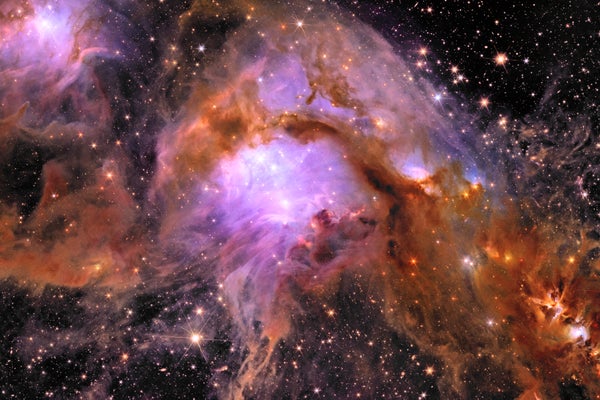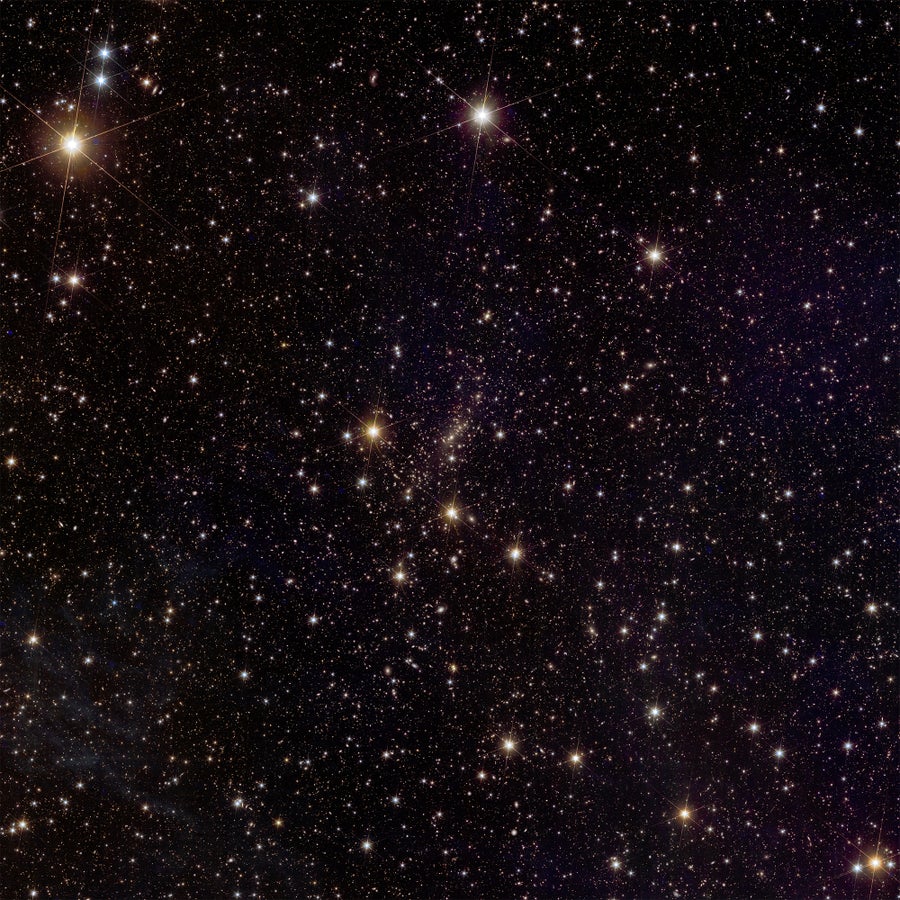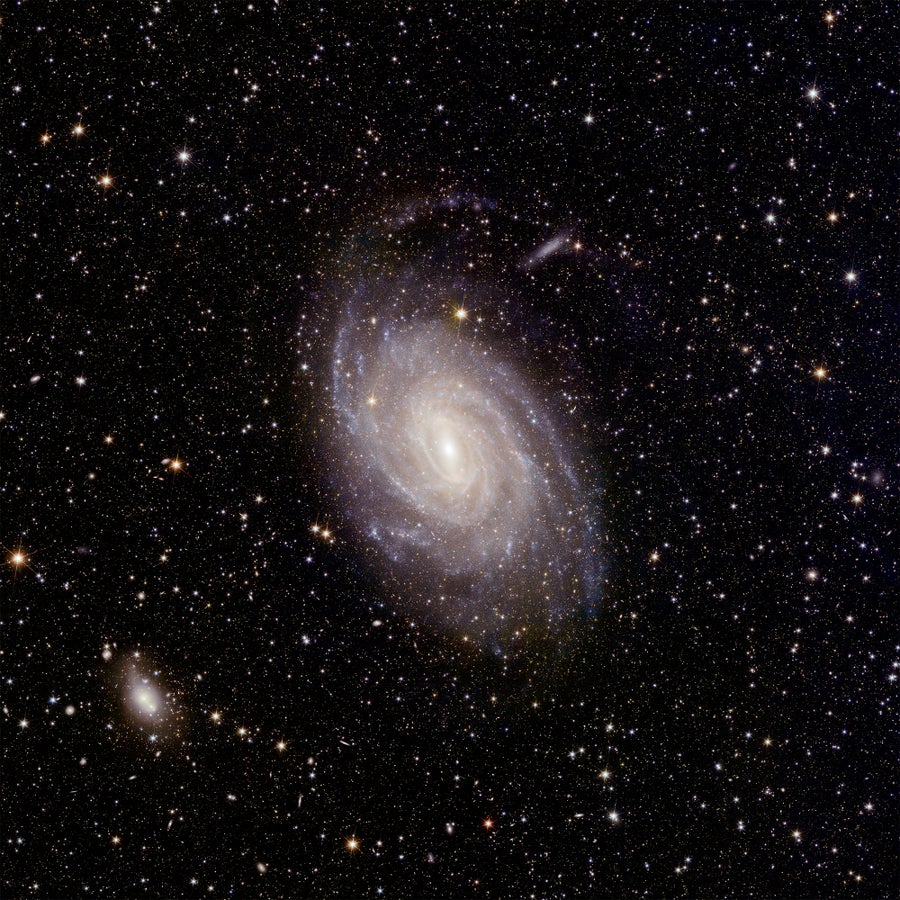Stunning New Images Show Bright Future for Euclid, a Telescope Studying the ‘Dark’ Universe
The latest images from Euclid, a European mission studying dark matter and dark energy, are spectacularly beautiful—and scientifically promising
By Phil Plait

A close-up of the star-forming region M78, from a large image captured by the European Space Agency’s Euclid telescope.
ESA/Euclid/Euclid Consortium/NASA, image processing by J.-C. Cuillandre (CEA Paris-Saclay), G. Anselmi (CC BY-SA 3.0 IGO)
The vast majority of the cosmos is made of different kinds of stuff we cannot see. We know it’s there, but it emits no light and may not even interact directly with normal matter (so we cannot touch it, either). How do you even begin to understand such things?
The key is to study them through the ways they do affect the universe. Dark matter has gravity, so it influences the way normal matter moves around and clumps up in galaxies. (Given how there’s five or more times as much dark matter as normal matter in the universe, I often wonder which one we should call “normal,” though.) It even dictates how light flows through the space it warps by its gravity. And dark energy is causing the expansion of the universe to accelerate, which changes how we measure distances to far-flung galaxies and alters the distribution of galaxies and galaxy clusters in larger-scale cosmic structures.
These are measurable effects, if you’re clever and have access to advanced technology. We humans are and we do, and now the European Space Agency (or ESA) has put an exceptionally powerful new tool into our kit: Euclid, a space-based observatory that is designed to reveal the secrets of the dark universe—and quite a bit about the visible universe, too.
On supporting science journalism
If you’re enjoying this article, consider supporting our award-winning journalism by subscribing. By purchasing a subscription you are helping to ensure the future of impactful stories about the discoveries and ideas shaping our world today.
As telescopes go, in some ways, Euclid is modest. It sports a 1.2-meter-wide mirror, only half the width of Hubble’s and one fifth the size of the one for the James Webb Space Telescope (JWST). But despite its smaller size, Euclid’s mirror is in one important respect superior to those of these two huge observatories: Unlike the narrow field of view provided by Hubble’s and JWST’s mirrors, Euclid’s offers a panoramic vista. Each of the telescope’s celestial snapshots can capture a staggering half a square degree of sky, more than twice the apparent area of the full moon. It scans a long, wide strip of the sky every day, and its lifetime goal is to observe an incredible 15,000 square degrees in total, more than one third of the entire sky. And it will do so in high resolution—the ability to see small details.
Euclid launched in July 2023, and the first preliminary images were released later that year. In May ESA upped the ante, releasing the telescope’s first fully calibrated science images and a passel of scientific papers to go with them. These results are visually and scientifically magnificent and offer a great preview of the mission’s promise.

Euclid’s new image of galaxy cluster Abell 2390.
ESA/Euclid/Euclid Consortium/NASA, image processing by J.-C. Cuillandre (CEA Paris-Saclay), G. Anselmi (CC BY-SA 3.0 IGO)
Abell 2390 is a cluster of galaxies nearly three billion light-years from Earth. It’s richly populated, with thousands of galaxies all gravitationally bound to one another. Clusters like this are a treasure trove for astronomers; they’re so massive that the gravity of all those combined galaxies warps space substantially—what’s called gravitational lensing—and light from even more distant galaxies has to pass through those distortions to reach us. The images of these background objects get distorted into arcs and other shapes, like seeing a reflection in a fun house mirror. The dark matter in the cluster contributes to this lensing effect, and by measuring the subtly distorted shapes of the more distant galaxies, scientists can create a map of that hidden material.
While that’s important, I was more impressed that Euclid has uncovered a stellar population in the cluster that, until now, was nearly invisible: stars in between galaxies. These stars are individually faint, but their combined glow allows them to be seen—with Euclid, at least. While they’ve been detectable with telescopes such as Hubble, those observations were confined to a narrow field of view and required careful targeting. Euclid sees the entire cluster in one fell swoop and can add up the light from all those rogue stars. This was done in an earlier observation of another galactic city called the Perseus cluster, and astronomers found that this intracluster light must be coming from many billions of stars at least. These outcasts are so numerous that they could have made an entire galaxy by themselves if they hadn’t instead been flung across the vast spaces between galaxies. As to what did that flinging, the astronomers suggest these stars were likely stripped away from smaller galaxies in the cluster’s outskirts, pulled out by the combined galaxies’ powerful gravitational tides.
The Abell 2390 image above was made using a combination of observations from Euclid’s two cameras. One, called simply the visible instrument, or VIS, detects light similar to what the human eye can see, from the green part of the spectrum out to the near infrared. The other, called the Near-Infrared Spectrometer and Photometer, or NISP, can see much further into the near-infrared—out to a wavelength of two microns, roughly three times longer than the longest-wavelength light that our eyes can see. Both cameras are big. And I do mean big: NISP is 64 megapixels, and VIS, astonishingly, is more than 600 megapixels! Even for an astronomical camera, that’s big. This large size is a key part of Euclid’s ability to get sharp images of such relatively gigantic swaths of the sky—the mirror system was also specifically designed to allow a wide field of view for the telescope.
NISP will help astronomers get a grasp of dark energy as well. This mysterious force is causing the universe to expand ever more quickly, with distant galaxies being at a different distance than a naive assumption of constant expansion would yield. Galaxies far enough from Earth undergo strong redshifts, with their light’s wavelength being stretched out on the journey to our telescopes by the intervening expansion of space. For very distant galaxies, this effect is so pronounced that what we’d otherwise see as visible light is shifted into infrared. NISP’s spectrometer breaks that deeply redshifted light up into individual wavelengths, which astronomers can then examine to measure the magnitude of the shift and therefore calculate the galaxy distances. JWST can do this as well, but Euclid, again, sees much more sky and therefore far more galaxies at a time, and mapping millions of galaxies over the past ten billion years of cosmic history means getting a better grip on the accelerated expansion. Astronomers also hope to be able to measure any changes in that acceleration in different parts of the universe as well, something previously not possible.

The large spiral galaxy NGC 6744, as seen by the Euclid telescope.
ESA/Euclid/Euclid Consortium/NASA, image processing by J.-C. Cuillandre (CEA Paris-Saclay), G. Anselmi (CC BY-SA 3.0 IGO)
Closer to home, Euclid took a look at the gorgeous spiral galaxy NGC 6744, about 30 million light-years from Earth. The telescope’s wide field of view easily unveils the entire galaxy and its environs in exquisite detail. Besides examining the overall structure and stellar population of the galaxy, Euclid can look around the object to search for much fainter satellite galaxies, dwarf companions common around big galaxies (our Milky Way has dozens of them, for example). Smaller galaxies swarming around a larger one can be especially sensitive tracers of dark matter’s subtle effects, so cataloging and studying these satellites could be another way for researchers to learn more about how the invisible substance helped guide galactic formation and evolution. Astronomers have already found a new one for NGC 6744 in the Euclid data, a promising start—and the observatory is expected to see thousands of galaxies like it over its six-year mission.

Euclid’s new image of Messier 78, a vibrant nursery of star formation enveloped in a shroud of interstellar dust.
ESA/Euclid/Euclid Consortium/NASA, image processing by J.-C. Cuillandre (CEA Paris-Saclay), G. Anselmi (CC BY-SA 3.0 IGO)
My favorite image from this release, though, is even closer to us: Messier 78, or M78, a star-forming cloud of gas and dust only about 1,300 light-years away. It’s part of the mind-stompingly huge Orion complex, an immense series of dark clouds of gas and dust floating between the stars that boasts the Orion Nebula and the Horsehead Nebula, as well as other iconic nebulae. M78 is what’s called a reflection nebula; two nearby massive young blue supergiant stars illuminate the cloud, and that light is scattered towards us, making the cloud’s dust appear blue. Euclid’s infrared and visible observations were combined to produce this stunning portrait of star birth. Warm hydrogen glows pinkish-purple in the image, while cosmic dust, composed of tiny grains of siliceous (rocky) and carbonaceous (sooty) material, appears reddish-brown.
Newborn stars interact strongly with their cocoon of material. Some, still in the process of formation, draw material in, while more mature stars can grow massive and become so fiercely bright that their light dissolves the material around them, creating huge cavities. This kind of stellar feedback is only partially understood, so high-resolution images like this one will be eagerly studied by astronomers all over the globe.
Smaller objects can form in these nebulae as well, including free-floating planets. Euclid can spot rogue planets with as little as four times Jupiter’s mass in M78. JWST spotted even lighter-weight free-floaters in the Orion Nebula, but again Euclid’s wide field of view means taking a larger, if shallower, survey of such objects in the nebula.
And all of this is just a taste of what Euclid can deliver. In another paper recently accepted for publication in Astronomy & Astrophysics, astronomers mapped out the gravitational distortion of star clusters by the Milky Way, and their results support theoretical predictions. Dozens of extremely distant ultraviolet-emitting galaxies have been spotted, which will help astronomers understand their role in the early universe, including the way they lit up the material around them in an event called reionization, a key event in the history of the young cosmos. More discoveries await us.
This is Euclid’s true power. By taking the measure of large chunks of the sky, a more definitive overview of the universe starts to become clear. Larger telescopes seeing smaller portions nail down the details, but big-picture breakthroughs often require a broader view. Euclid lets astronomers take that step back, which may very well result in a big step forward in our understanding.
>>> Read full article>>>
Copyright for syndicated content belongs to the linked Source : Scientific American – https://www.scientificamerican.com/article/dark-matter-telescopes-dazzling-new-images-shine/










